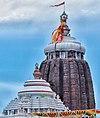Mahapurusha Jasobanta Dasa | |
|---|---|
 Gadi of Mahapurusa Jasobanta Dasa | |
| Native name | ଯଶୋବନ୍ତ ଦାସ |
| Born | 1487[1][2] Adhanga, Jagatsinghpur, Odisha[3] |
| Occupation | Poet |
| Language | Odia |
| Period | Bhakti age |
| Genre | Poetry,Ballads |
| Subject | Mythology,Philosophy |
| Notable works | Gobindachandra Tika, Prema Bhakti Brahma Gita[4][5] |
| Spouse | Anjana Devi |
Jasobanta Dasa (Odia: [d͡ʒɔsobɔnt̪ɔ d̪aːsɔ] ⓘ; born c. 1487) was an Odia poet, litterateur and mystic. He was one of the five great poets in Odia literature, the Panchasakha named Sri Ananta Dasa, Sri Jagannatha Dasa, Sri Balarama Dasa and Sri Achyutananda Dasa during the Bhakti age of literature.[5]
Personal life
[edit]Early life of Jasobanta is mainly sourced from the work Jasobanta Dasanka Chaurashi Agyan (Eighty-four arts of Jasobanta Dasa) by one of his disciples Sudarshan Das.[5] He was born at village Nandigrama of Adhangagarh , Jagatsinghpur, part of undivided Cuttack District. His father's name was Ballabhadra Malla and his mother's name was Rekha Dei.[5] He wed Anjana Devi, the sister of Adhangagarh ’s king Raghunath Champatti. He later took sannyasa and travelled to numerous holy places throughout India, where he attained mystic powers and gained the ability to change his form at will. He chanted and taught the Shyama mula mantra.
Govinda chandra, Shiva sarodaya, Sasti mala, Prema bhakti, Brahma gita, Atma pariche gita, a Malika, and several bhajans were among his works. Govinda chandra became extremely popular in Assam, Bengal, and northern India; it is primarily associated with traditional dance and dance instruction, both of which are associated with the Vaishnava tradition. He came to Puri by the inspiration of Sri Chaitanya. He got initiated into Vaishnavism during Sri chaitanya's stay in Puri.[2] Lohi Das was his most devoted disciple.He dismembered himself on Margasira sukla Sasti.
Literary works
[edit]A list of his known works is as below.
- Gobinda Chandra
- Prema Bhakti Brahma Gita
- Siba Swarodaya
References
[edit]- ^ Das, S. (2010). Lord Jagannath. Sanbun Publishers. p. 26. ISBN 978-93-80213-22-4. Retrieved 2019-10-09.
- ^ a b Mohan Lal (1992). Encyclopaedia of Indian Literature: sasay to zorgot. Sahitya Akademi. pp. 4628–. ISBN 978-81-260-1221-3. Retrieved 19 December 2012.
- ^ Praharaj, Gopal Chandra (2016-10-23). "Purnachandra Odia Bhashakosha by Gopal Chandra Praharaj (Preface + All 7 Volumes) : Gopal Chandra Praharaj : Free Download, Borrow, and Streaming : Internet Archive". Internet Archive. p. 6782. Retrieved 2019-10-09.
- ^ Paniker, K.A.; Sahitya Akademi (1997). Medieval Indian Literature: Surveys and selections. Medieval Indian Literature. Sahitya Akademi. p. 409. ISBN 978-81-260-0365-5. Retrieved 2019-10-09.
- ^ a b c d Mukherjee, P. (1981). The History of Medieval Vaishnavism in Orissa. Asian Educational Services. pp. 85–86. ISBN 978-81-206-0229-8. Retrieved 2019-10-09.
https://historyofodisha.in/pancha-sakhas-of-medieval-odisha/

